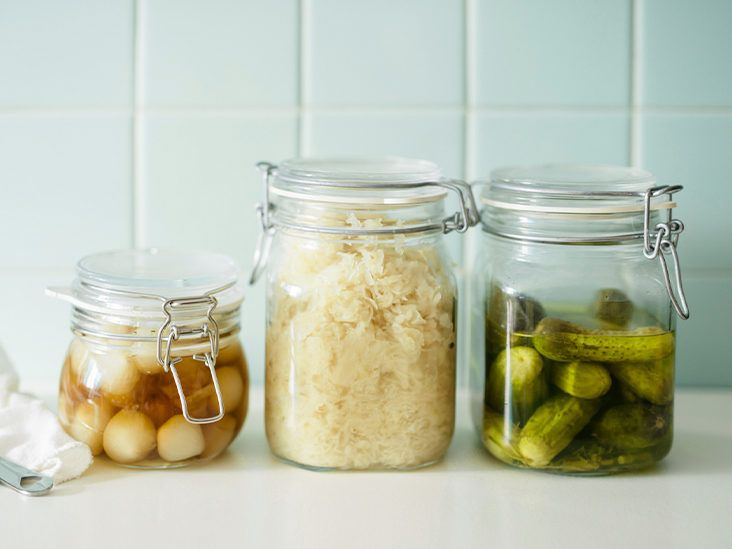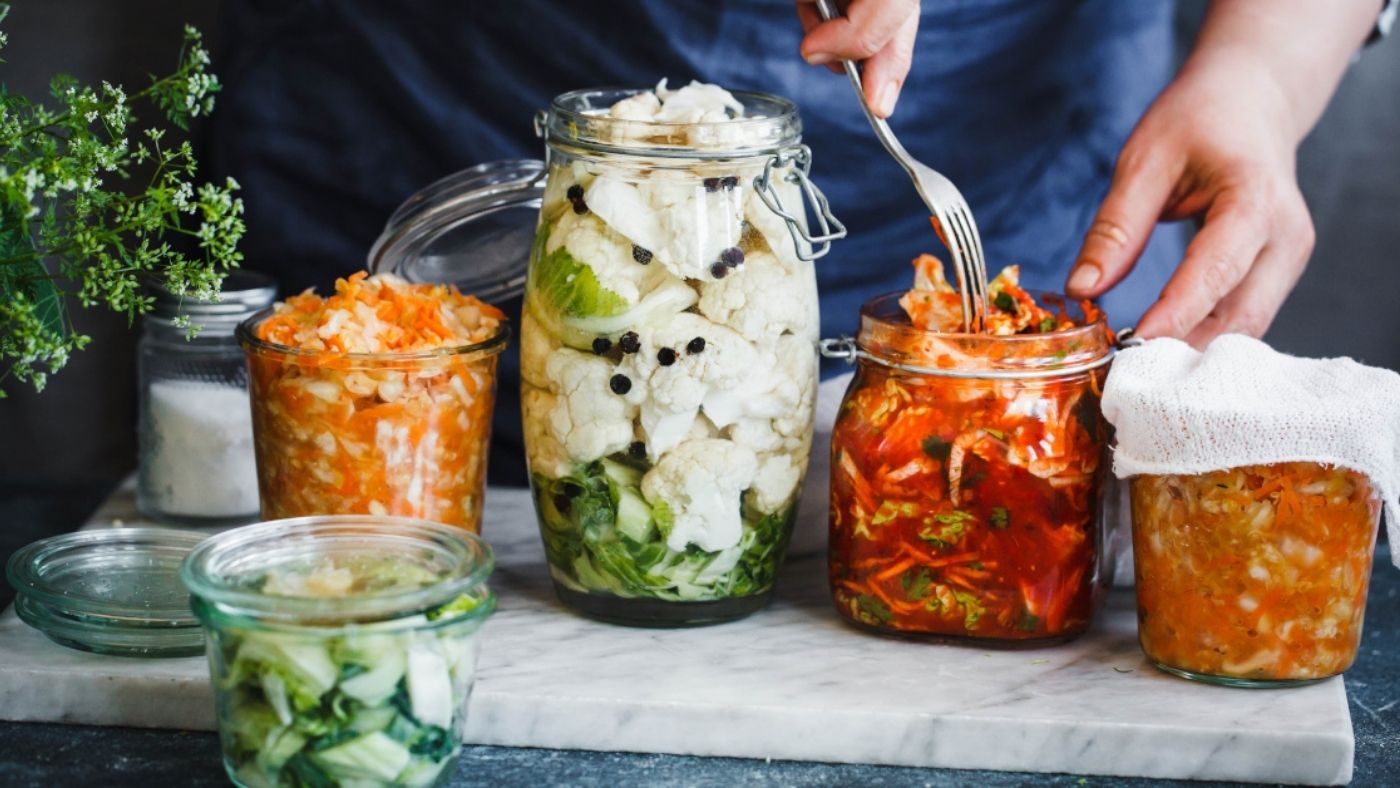Unlocking Flavor: Embark on a Journey of Fermentation for Beginners


Benefits of Fermentation
Fermentation is not just a scientific process, but also a delightful way to enhance the flavors and nutritional value of food and beverages. If you're new to fermentation, you might be wondering what all the fuss is about. Let's explore some of the fantastic benefits it can offer!
Health benefits of fermented foods and beverages
-
Improved Digestion: Fermented foods are rich in beneficial bacteria that can help restore the balance of your gut microbiome. These friendly bacteria aid in the breakdown and absorption of nutrients, leading to better digestion.
-
Boosted Immune System: The probiotics present in fermented foods stimulate the production of antibodies, enhancing your immune response. This can help prevent infections and reduce the risk of chronic diseases.
How fermentation enhances nutrient absorption in the body
-
Increased Nutrient Bioavailability: Fermentation breaks down complex compounds in food, making essential nutrients more accessible for absorption. This includes increasing the bioavailability of vitamins, minerals, and antioxidants, providing your body with better nourishment.
-
Reduced Antinutrients: Fermentation reduces antinutrients like phytic acid and tannins that can hinder the body's ability to absorb nutrients. By deactivating these compounds, fermentation improves the overall nutrient absorption process.
The role of probiotics in gut health and the immune system
-
Optimal Gut Health: Fermented foods contain live probiotics that populate your gut with beneficial bacteria. These probiotics promote a healthy gut environment, improve digestion, and may help alleviate digestive issues like bloating and constipation.
-
Enhanced Immune Function: Probiotics support a robust immune system by strengthening the gut barrier, reducing inflammation, and modulating immune responses. This can lead to a lower risk of allergies and infections.
Incorporating fermented foods and beverages into your diet can be a delicious way to promote digestive health, boost your immune system, and improve nutrient absorption. Start by experimenting with simple ferments like sauerkraut, kombucha, or yogurt, and enjoy the fantastic benefits fermentation has to offer!

Getting Started with Fermentation
So you've heard about fermentation and all the delicious foods and beverages it can produce, but you're not quite sure where to begin? Don't worry, we've got you covered!
Essential equipment and ingredients for beginners
Before diving into the world of fermentation, you'll need a few key items to get started. Here are the essentials:
-
Fermentation vessel: This is where the magic happens. You can choose between various options such as glass jars, ceramic crocks, or airlock fermentation lids.
-
Ingredients: The most common ingredient for fermentation is salt, which acts as a natural preservative. You can also add vegetables, fruits, or grains to create different flavors.
Choosing the right fermentation vessel and tools
When selecting your fermentation vessel, consider the following factors:
-
Size: Choose a vessel that can accommodate your desired quantity of fermenting food or beverage.
-
Material: Glass or ceramic vessels are recommended as they are non-reactive and won't affect the taste or quality of your fermentation.
-
Tools: Depending on your chosen fermentation method, you may need additional tools like weights to keep the food submerged or airlock lids for better control of the fermentation process.
A step-by-step guide to the fermentation process
-
Prepare your ingredients by washing them thoroughly and chopping or shredding them if necessary.
-
Add the salt or any other desired seasonings to your ingredients and mix well. This helps to draw out the moisture and create an environment conducive for fermentation.
-
Transfer the mixture to your fermentation vessel, making sure to leave some headspace for expansion during fermentation.
-
Press the ingredients down firmly to remove any trapped air and ensure they are fully submerged in their own juices.
-
Place the lid on your fermentation vessel, ensuring it is airtight if using an airlock lid.
-
Store the vessel in a cool, dark place away from direct sunlight and let nature do its work. Fermentation times can vary depending on the recipe, so be sure to check on it periodically.
Remember, fermentation is a process of trial and error, so don't be afraid to experiment, taste, and adjust as you go along. Enjoy the journey and savor the unique flavors that fermentation brings to your table!

Popular Fermented Foods and Recipes
Introduction to different types of fermented foods
If you're interested in trying your hand at fermentation, you'll be pleased to know that there are many delicious and nutritious fermented foods to explore. Some popular examples include sauerkraut, kimchi, yogurt, kefir, and kombucha. These foods undergo a process called lacto-fermentation, in which beneficial bacteria convert sugars into lactic acid, preserving the food and creating a tangy flavor.
Classic sauerkraut recipe and variations
Sauerkraut is one of the easiest fermented foods to make at home, requiring just two simple ingredients: cabbage and salt. To start, finely shred the cabbage and massage it with salt until it releases its natural juices. Pack the cabbage tightly into a jar, making sure it's submerged in the brine. Cover with a clean cloth and let it sit at room temperature for a few days or weeks, depending on your desired level of tanginess. You can also add spices, such as caraway seeds or garlic, to enhance the flavor.
Making your own kombucha at home
Kombucha is a fermented tea that is both refreshing and probiotic-rich. To make your own kombucha, you'll need a SCOBY (Symbiotic Culture of Bacteria and Yeast), black or green tea, sugar, and a glass jar. Start by brewing the tea and dissolving sugar in it, then let it cool. Place the SCOBY in the jar, pour the tea over it, and cover with a cloth. Let it ferment for about a week, or until it reaches your preferred taste. You can also add fruit or herbs during the second fermentation for added flavor.
With these popular fermented foods and easy-to-follow recipes, you'll be well on your way to expanding your culinary skills and enjoying the many health benefits that fermentation has to offer. So, grab your ingredients and get fermenting!

Troubleshooting and Common Mistakes
So, you've decided to venture into the world of fermentation! As a beginner, it's natural to encounter a few bumps along the way. Don't worry, though. We've got you covered with some troubleshooting tips and common mistakes to avoid.
Identifying signs of successful fermentation
How do you know if your fermentation is going well? Look for these signs:
-
Bubbles and fizz: A lively fermentation process is marked by the presence of bubbles and fizz on the surface of the fermenting mixture. This indicates that the beneficial bacteria or yeast are actively breaking down sugars into alcohol or lactic acid.
-
Pleasant aroma: A successful fermentation will emit a pleasant, tangy aroma. If you notice any foul or off-putting smells, it may be a sign of contamination.
Addressing common fermentation issues
What if something goes wrong during the fermentation process? Here are some common issues and how to address them:
-
Fermentation not starting: If you don't see any signs of fermentation within a few days, it could indicate insufficient yeast or bacteria. Try adding a small amount of active starter culture or wild yeast to kickstart the process.
-
Mold growth: Mold is a common problem in fermentation. If you spot mold on the surface of your fermenting mixture, it's important to discard the entire batch to prevent contamination.
Preventing contamination and maintaining hygiene
Contamination is a fermenter's worst enemy. To maintain hygiene and prevent unwanted bacteria or mold growth:
-
Sanitize your equipment: Clean all utensils, jars, and tools with hot soapy water or use a mild bleach solution before beginning the fermentation process.
-
Avoid cross-contamination: Ensure that your fermentation area is free from other foods or ingredients that may introduce unwanted microorganisms.
Remember, fermentation is a learning process, and it's normal to make mistakes. Stay curious, experiment, and enjoy the tangy, flavorful world of fermentation!

Exploring Advanced Fermentation Techniques
Introduction to secondary fermentation and its benefits
So, you've mastered the basics of fermentation and are ready to take your skills to the next level. Welcome to the world of advanced fermentation techniques! One technique you should definitely explore is secondary fermentation. Unlike primary fermentation, which involves letting your ingredients ferment in an airtight container, secondary fermentation allows for the introduction of additional flavors and ingredients to create a more complex and unique taste. This process can enhance the flavor and texture of your fermented creations, giving them an extra wow factor.
Experimenting with different flavors and ingredients
One of the exciting aspects of advanced fermentation is the ability to experiment with a wide range of flavors and ingredients. From fruits and spices to herbs and even tea, the possibilities are endless. Don't be afraid to get creative and try combinations that you've never thought of before. For example, you can add fresh berries to your kombucha or infuse your sauerkraut with garlic and dill. The key is to let your taste buds guide you and discover what flavors work well together. Just remember to keep track of your experiments so you can recreate your favorite creations in the future.
Creating your own unique fermented recipes
Now that you're comfortable with advanced fermentation techniques, it's time to put your creativity to the test and create your own unique fermented recipes. Start by brainstorming ideas and thinking about the flavors and ingredients that inspire you. Experiment with different fermentation times, temperatures, and ratios to achieve the desired results. Keep in mind that fermentation is a process of trial and error, so don't be discouraged if your first attempt doesn't turn out exactly as planned. Learn from your mistakes and make adjustments along the way. With time and practice, you'll develop your own signature fermented creations that will impress your family and friends.
Remember, fermentation is both an art and a science. Don't be afraid to push the boundaries and discover new flavors and techniques. Enjoy the journey of exploration and experimentation, and have fun creating your own unique fermented masterpieces. Cheers to your next fermentation adventure!

Storage and Preservation of Fermented Foods
Appropriate storage methods for various fermented products
Congratulations on taking the first step into the world of fermentation! Now that you have prepared your delicious fermented foods, it's important to know how to store them properly to maintain their flavor and quality.
Different fermented products require different storage methods. Here are a few examples:
-
Sauerkraut and Kimchi: These popular fermented vegetables can be stored in airtight containers or jars in the refrigerator. Make sure to press them down to remove any air bubbles, which can lead to spoilage.
-
Kombucha: After the fermentation process, transfer your homemade kombucha to glass bottles with airtight caps. Store them in the refrigerator to slow down fermentation and maintain carbonation.
-
Yogurt: If you've made homemade yogurt, store it in airtight containers in the refrigerator. The cold temperature will slow down the fermentation process and keep the yogurt fresh.
Extending the shelf life of fermented foods
To extend the shelf life of your fermented foods, consider these tips:
-
Use proper fermentation techniques: Ensure your fermentation process is done correctly to prevent spoilage and increase the shelf life of your products.
-
Keep them cool: Most fermented foods should be stored in the refrigerator or a cool, dark place. This slows down the fermentation process and helps preserve the flavors.
-
Avoid cross-contamination: Use clean utensils and containers when handling your fermented foods to prevent introducing unwanted bacteria and spoilage.
Proper labeling and organizing fermented goods
Labeling and organizing your fermented goods will make it easier for you to find and enjoy them later. Here are a few tips:
-
Date and label: Use labels or markers to indicate the date of fermentation and the type of fermented food in each container. This will help you keep track of freshness and avoid confusion.
-
Organize by date: Arrange your fermented goods in order of their fermentation dates, with the oldest in front. This will ensure that you consume them in a timely manner.
Remember, proper storage and organization are crucial for maintaining the quality and freshness of your fermented foods. Enjoy the wonderful flavors and health benefits of your homemade fermented creations!

Frequently Asked Questions on Fermentation
Addressing common queries and concerns
Are you a newbie in the world of fermentation? Don't worry, we've got you covered! Here are some frequently asked questions and answers to help you get started on your fermentation journey.
Q: What exactly is fermentation?
Fermentation is a natural process that converts sugar into acids, gases, or alcohol using yeast, bacteria, or a combination of both. It is a crucial process in food and beverage production, as well as in preserving and enhancing flavors.
Q: Why should I try fermentation?
Fermentation not only adds depth and complexity to the flavors of your food and beverages but also offers several health benefits. It increases the nutritional value of your food, aids digestion, and supports a healthy gut microbiome.
Q: What are some common fermented foods and beverages?Some of the most popular fermented foods and beverages include yogurt, sauerkraut, kimchi, kombucha, kefir, miso, and sourdough bread.
Q: Is it safe to ferment food at home?Yes, it is generally safe to ferment food at home. However, it is important to follow proper sanitation and food safety practices to prevent the growth of harmful bacteria. Start with simple recipes and gradually expand your skills as you gain more experience.
Q: How do I get started with fermentation?To get started with fermentation, you'll need some basic equipment like fermentation jars, airlocks, and starter cultures or fermentation starters. Choose a recipe that appeals to you, gather the necessary ingredients, and follow the instructions carefully. Don't forget to be patient, as fermentation takes time!
Q: How do I know if my fermentation is successful?A successful fermentation will have a tangy or sour taste, the presence of bubbles or fizziness, and a pleasant aroma. If you notice any signs of mold, unusual colors, or foul odors, it is best to discard the batch and start over.
Remember, fermentation is both an art and a science. Don't be afraid to experiment and have fun with different flavors and combinations. Happy fermenting!



